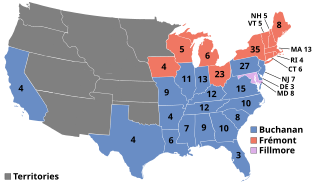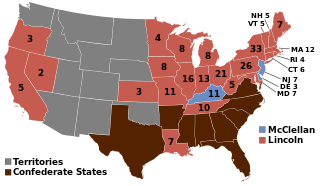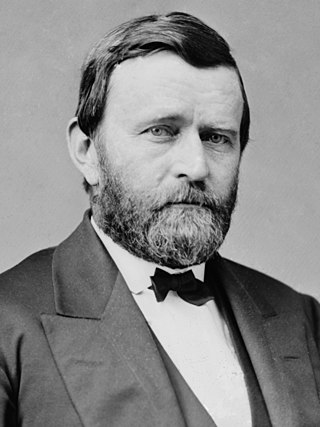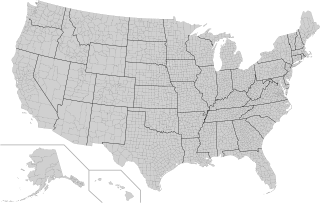
Presidential elections were held in the United States on November 4, 1856. Democratic nominee James Buchanan defeated Republican nominee John C. Frémont and Know Nothing/Whig nominee Millard Fillmore. The main issue was the expansion of slavery as facilitated by the Kansas–Nebraska Act of 1854. Buchanan defeated President Franklin Pierce at the 1856 Democratic National Convention for the nomination. Pierce had become widely unpopular in the North because of his support for the pro-slavery faction in the ongoing civil war in territorial Kansas, and Buchanan, a former Secretary of State, had avoided the divisive debates over the Kansas–Nebraska Act by being in Europe as the Ambassador to the United Kingdom.

Presidential elections were held in the United States on November 8, 1864, near the end of the American Civil War. Incumbent President Abraham Lincoln of the National Union Party easily defeated the Democratic nominee, former General George B. McClellan, by a wide margin of 212–21 in the electoral college, with 55% of the popular vote. For the election, the Republican Party and some Democrats created the National Union Party, especially to attract War Democrats.

Presidential elections were held in the United States on November 3, 1868. In the first election of the Reconstruction Era, Republican nominee Ulysses S. Grant defeated Horatio Seymour of the Democratic Party. It was the first presidential election to take place after the conclusion of the American Civil War and the abolition of slavery. It was the first election in which African Americans could vote in the reconstructed Southern states, in accordance with the First Reconstruction Act.

Brooklyn is a borough of New York City located at the westernmost end of Long Island in the State of New York. Formerly an independent city, the borough is coextensive with Kings County, one of twelve original counties established under British rule in 1683 in the then Province of New York. As of the 2020 United States census, the population stood at 2,736,074, making it the most populous of the five boroughs of New York City, and the most populous county in the state. Brooklyn, at 37,339.9 inhabitants per square mile (14,417.0/km2), is the second most densely populated county in the U.S. after Manhattan, as of 2022. Had Brooklyn remained an independent city, it would now be the fourth most populous American city after the rest of New York City, Los Angeles, and Chicago.

Suffolk County is the easternmost county in the U.S. state of New York, constituting the eastern two-thirds of Long Island. It is bordered to its west by Nassau County, to its east by Gardiners Bay and the open Atlantic Ocean, to its north by Long Island Sound, and to its south by the Atlantic Ocean.

Putnam County is a county in the U.S. state of New York. As of the 2020 census, the population was 97,668. The county seat is Carmel, within one of the county's six towns. The county is part of the Hudson Valley region.

In the United States, a county or county equivalent is an administrative or political subdivision of a U.S. state or other territories of the United States which consists of a geographic area with specific boundaries and usually some level of governmental authority. The term "county" is used in 48 states, while Louisiana and Alaska have functionally equivalent subdivisions called parishes and boroughs, respectively. Counties and other local governments exist as a matter of U.S. state law, so the specific governmental powers of counties may vary widely between the states, with many providing some level of services to civil townships, municipalities, and unincorporated areas. Certain municipalities are in multiple counties; New York City is uniquely partitioned into five counties, referred to at the city government level as boroughs. Some municipalities have been consolidated with their county government to form consolidated city-counties, or have been legally separated from counties altogether to form independent cities. Conversely, counties in Connecticut and Rhode Island, eight of Massachusetts's 14 counties, and Alaska's Unorganized Borough have no government power, existing only as geographic distinctions.
A county court is a court based in or with a jurisdiction covering one or more counties, which are administrative divisions within a country, not to be confused with the medieval system of county courts held by the high sheriff of each county.

Andrew Goodman was an American civil rights activist. He was one of three Congress of Racial Equality (CORE) workers murdered in Philadelphia, Mississippi, by members of the Ku Klux Klan in 1964. Goodman and two fellow activists, James Chaney and Michael Schwerner, were volunteers for the Freedom Summer campaign that sought to register African-Americans to vote in Mississippi and to set up Freedom Schools for black Southerners.
The Supreme Court of the State of New York is the trial-level court of general jurisdiction in the judiciary of New York. It is vested with unlimited civil and criminal jurisdiction, although in many counties outside New York City it acts primarily as a court of civil jurisdiction, with most criminal matters handled in County Court.
A civil township is a widely used unit of local government in the United States that is subordinate to a county, most often in the northern and midwestern parts of the country. The term town is used in New England, New York, as well as Wisconsin to refer to the equivalent of the civil township in these states; Minnesota uses "town" officially but often uses it and "township" interchangeably. Specific responsibilities and the degree of autonomy vary in each state. Civil townships are distinct from survey townships, but in states that have both, the boundaries often coincide, especially in Indiana, Ohio, and Illinois, and may completely geographically subdivide a county. The U.S. Census Bureau classifies civil townships as minor civil divisions. Currently, there are 20 states with civil townships, including Indiana, Ohio, Illinois, Michigan, Iowa, Minnesota, Wisconsin, Missouri, Kansas, Nebraska, South Dakota, North Dakota, Pennsylvania, and West Virginia.
A township in some states of the United States is a small geographic area.

The government of New York City, headquartered at New York City Hall in Lower Manhattan, is organized under the New York City Charter and provides for a mayor-council system. The mayor is elected to a four-year term and is responsible for the administration of city government. The New York City Council is a unicameral body consisting of 51 members, each elected from a geographic district, normally for four-year terms. Primary elections for local offices use ranked choice voting, while general elections use plurality voting. All elected officials are subject to a two consecutive-term limit. The court system consists of two citywide courts and three statewide courts.
An incorporated town is a town that is a municipal corporation.

Erastus Root was an early American lawyer and politician from New York. He is most notable for serving four separate non-consecutive terms in the U.S. House of Representatives in the early 19th century.

Sanford Elias Church was an American lawyer and Democratic politician. He served as the lieutenant governor of New York and chief judge of the New York Court of Appeals.

The 1921 New York state election was held on November 8, 1921, to elect a judge of the New York Court of Appeals, as well as all members of the New York State Assembly. Six amendments to the State Constitution were also proposed.

The 7th New York State Legislature, consisting of the New York State Senate and the New York State Assembly, met from January 21 to May 12, 1784, during the seventh year of George Clinton's governorship, at New York City.












